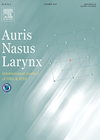
Journal Reviews
Two reliable endoscopic myringoplasty techniques for anterior tympanic membrane perforations
Difficulties that arise in closing anterior perforations in the tympanic membrane are due to a narrow isthmus of the external auditory canal and an anterior wall bulge which obscures the most anterior part of the tympanic membrane. The conventional microscopic...
Which graft is better for type 1 tympanoplasty in elderly patients?
Type 1 tympanoplasty is a procedure performed to repair tympanic membrane perforations, primarily to reduce otorrhoea. This may subsequently lead to improvement of hearing. The common graft materials used are temporalis fascia and cartilage from tragus or concha. The authors...
A comparison of same day with staged bilateral cartilage graft tympanoplasty for tubotympanic CSOM
This randomised, controlled study compares the tympanoplasty outcomes in two groups of patients: one undergoing bilateral tympanoplasty on the same day (18 patients, 36 ears) and the other having the same procedure done on different days, with a gap of...
Cartilage myringoplasty to treat patulous eustachian tube dysfunction
Patulous eustachian tube (PET) dysfunction, where the eustachian tube is abnormally opened at rest, is a notoriously difficult condition to treat. Symptoms can mimic symptoms of superior semicircular canal dehiscence: autophony, aural fullness, hyperacusis and breathing synchronous tinnitus. Treatment has...
Prognostic factors for myringoplasty
This retrospective study looked at the factors that were associated with a higher success rate for tympanic membrane perforation closure. The authors looked at 247 procedures. They compared the results of temporalis fascia versus tragal cartilage. The cartilage grafts had...










